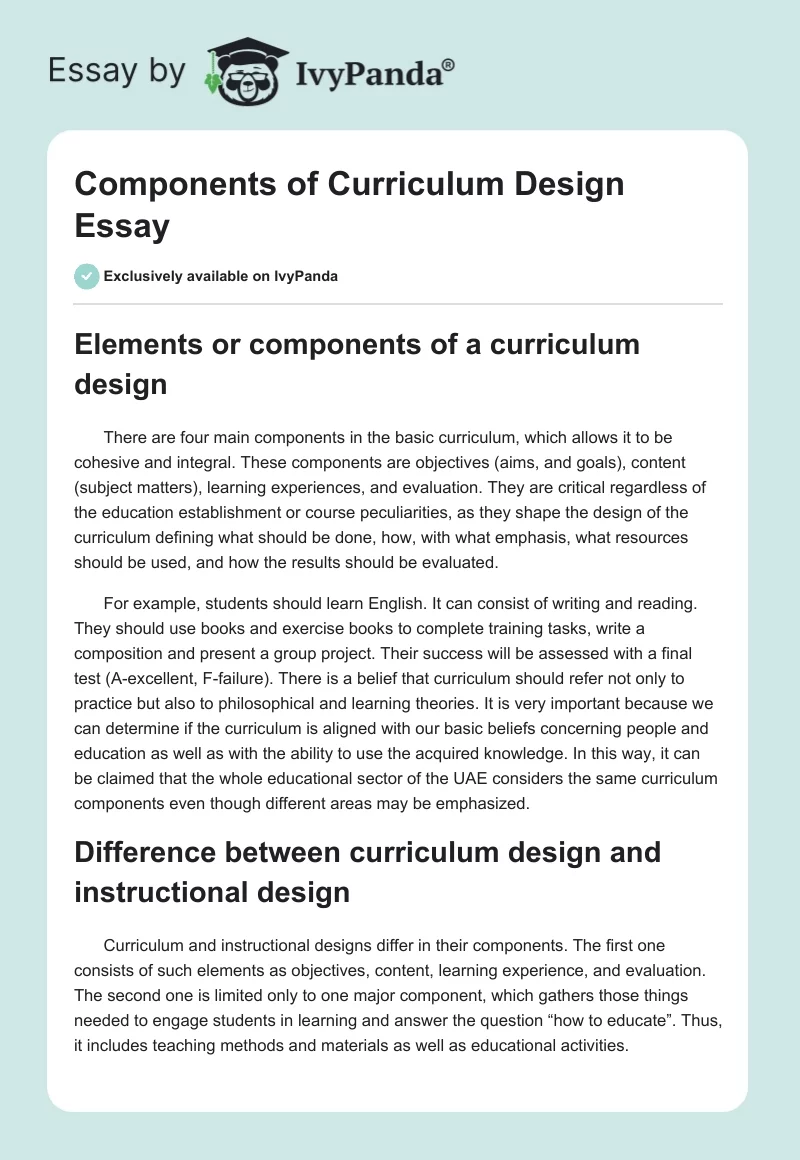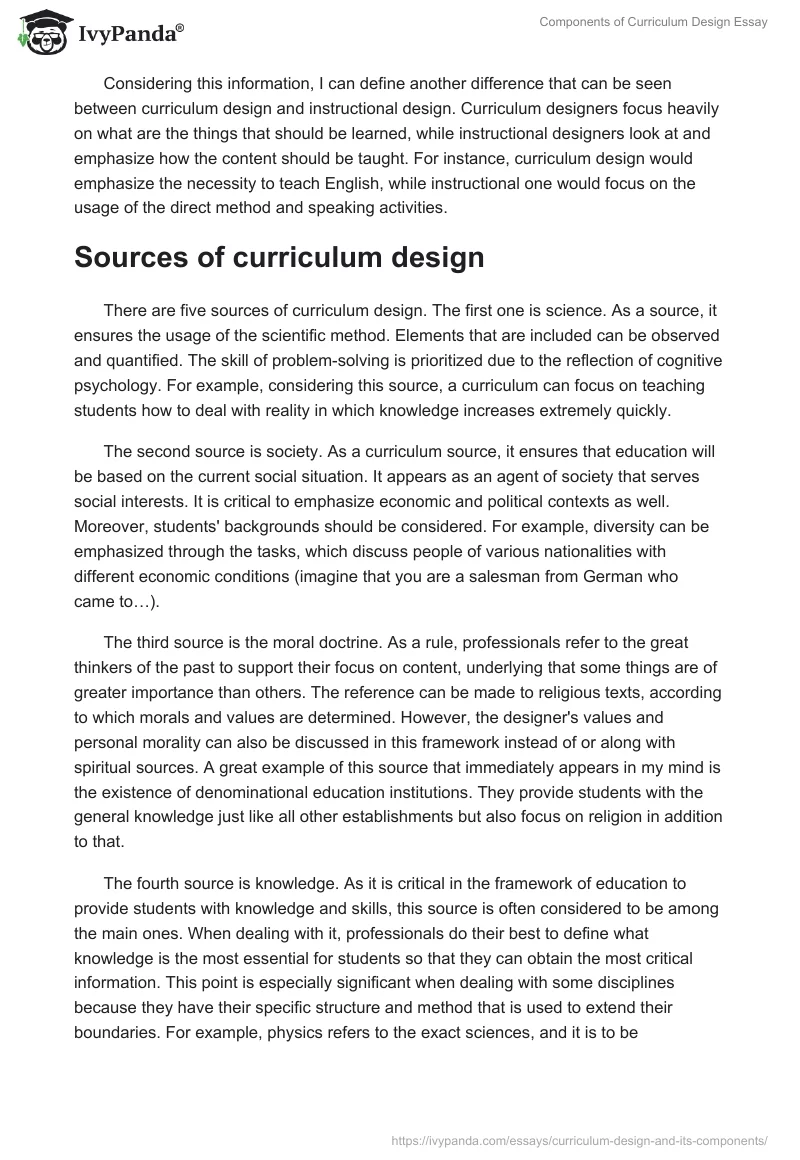Elements or components of a curriculum design
There are four main components in the basic curriculum, which allows it to be cohesive and integral. These components are objectives (aims, and goals), content (subject matters), learning experiences, and evaluation. They are critical regardless of the education establishment or course peculiarities, as they shape the design of the curriculum defining what should be done, how, with what emphasis, what resources should be used, and how the results should be evaluated.
For example, students should learn English. It can consist of writing and reading. They should use books and exercise books to complete training tasks, write a composition and present a group project. Their success will be assessed with a final test (A-excellent, F-failure). There is a belief that curriculum should refer not only to practice but also to philosophical and learning theories. It is very important because we can determine if the curriculum is aligned with our basic beliefs concerning people and education as well as with the ability to use the acquired knowledge. In this way, it can be claimed that the whole educational sector of the UAE considers the same curriculum components even though different areas may be emphasized.
Difference between curriculum design and instructional design
Curriculum and instructional designs differ in their components. The first one consists of such elements as objectives, content, learning experience, and evaluation. The second one is limited only to one major component, which gathers those things needed to engage students in learning and answer the question “how to educate”. Thus, it includes teaching methods and materials as well as educational activities.
Considering this information, I can define another difference that can be seen between curriculum design and instructional design. Curriculum designers focus heavily on what are the things that should be learned, while instructional designers look at and emphasize how the content should be taught. For instance, curriculum design would emphasize the necessity to teach English, while instructional one would focus on the usage of the direct method and speaking activities.
Sources of curriculum design
There are five sources of curriculum design. The first one is science. As a source, it ensures the usage of the scientific method. Elements that are included can be observed and quantified. The skill of problem-solving is prioritized due to the reflection of cognitive psychology. For example, considering this source, a curriculum can focus on teaching students how to deal with reality in which knowledge increases extremely quickly.
The second source is society. As a curriculum source, it ensures that education will be based on the current social situation. It appears as an agent of society that serves social interests. It is critical to emphasize economic and political contexts as well. Moreover, students’ backgrounds should be considered. For example, diversity can be emphasized through the tasks, which discuss people of various nationalities with different economic conditions (imagine that you are a salesman from German who came to…).
The third source is the moral doctrine. As a rule, professionals refer to the great thinkers of the past to support their focus on content, underlying that some things are of greater importance than others. The reference can be made to religious texts, according to which morals and values are determined. However, the designer’s values and personal morality can also be discussed in this framework instead of or along with spiritual sources. A great example of this source that immediately appears in my mind is the existence of denominational education institutions. They provide students with the general knowledge just like all other establishments but also focus on religion in addition to that.
The fourth source is knowledge. As it is critical in the framework of education to provide students with knowledge and skills, this source is often considered to be among the main ones. When dealing with it, professionals do their best to define what knowledge is the most essential for students so that they can obtain the most critical information. This point is especially significant when dealing with some disciplines because they have their specific structure and method that is used to extend their boundaries. For example, physics refers to the exact sciences, and it is to be approached step by step, while environmental studies can be adapted to the specific interest.
Thus, disciplined knowledge presupposes unique approaches that cannot be substituted or inverted, while undisciplined knowledge allows dealing with a wide variety of approaches and different training techniques. Still, the value of the knowledge and its ranking are to be taken into consideration in both situations.
Finally, the learner can be treated as a source. In this situation, it is significant to find out as much information about students as possible because it will be used to design the curriculum. This approach was developed based on the psychological foundations that refer to cognitive research and reveal the great importance of “learning by doing”. For example, professionals should identify the interests of their learners as well as their background to adapt to the curriculum. In this way, when discussing art, more emphasis can be made on modern works, etc.
Curriculum dimensions
Six curriculum dimensions are to be taken into consideration during the design. The first one is the scope. It deals with the breadth and depth of the very curriculum, which means that the content, topics, experiences, and organizing peculiarities are to be discussed. Still, in some situations, it can include only the main topics and activities. The next dimension is the sequence, which is seen as the order of the knowledge. The third one is a continuity that refers to the constant repetition of particular knowledge or skills. For example, children are taught to read while being little, but the development of this skill is measured more than once to determine the progress made with time.
The integration of the curriculum is a collaboration of both knowledge and experience. Reference to the previously learned information improves learners’ understanding. The articulation of the curriculum is more extended than its integration. It presupposes the connection between different curriculum components. Thus, an English topic can be connected with the literature one and can also be discussed in the previous grade. The balance presupposes that each aspect should be emphasized appropriately.
Curriculum design models
There are three main models of the curriculum design. The first one deals with subject-centered designs. They are used more often than other types and have the widest range of classifications. Their focus is on the content organization. The second type includes learner-centered designs. They are based on students’ characteristics, their interests, and background. Finally, the problem-centered designs focus on social issues. These can be the problems of both individuals and society. An example that appears in my mind deals with the way school curriculums are typically designed. During the first grades, attention is mainly paid to the students, the secondary school focuses on subjects, and the high school discusses various issues and their solutions.
What are the components of the ISD model?
There are five components of the instructional systems design. The first one is analysis, which focuses on the collection and interpretation of the information needed to be able to determine learning outcomes. Then design comes; it emphasizes the preparation of the selected program materials. After that, development is considered. Here, the designer prepares a particular training program. Then one passes to the implementation stage, during which the actual instruction is carried out. Then the final component comes, which is the evaluation of the results. For instance, all instruction designs that are recommended to be used in practice follow this model, as it proves that they are authoritative and appropriate.
What are the components of the CBM model?
There are seven components in the competency-based education model. The duty area presupposes that job responsibilities are to be grouped, considering the similarity of tasks. The next component is the task/competency which describes measurable elements in the aspects of knowledge, skill, or behavior related to the occupational area. Performance objectives focus on the students’ presentation and determine if they mastered a task or competency.
Performance measures reveal how the students’ performance will be assessed. Enabling objectives to provide recommended steps that lead to the improvement of the performance objective, including all skills. Instructional activities focus on assignments that help students achieve success. They include activities that involve group or even individual projects as well as other types of work, such as written oral assignments. Critical thinking activities also allow mastering skills and knowledge, especially those related to problem-solving. Resources are those materials that are used to teach. For example, resources include books, maps, computers, boards, etc.
Reflection
There is a wide range of different instructional models that can be used by professionals to provide learners with the knowledge and skills they require. In general, they are divided into three basic groups, depending on their focus that can be made on the subject, learner, or problem. I prefer those models that are based on progressivism because this philosophy underlines the necessity to enhance the current situation and encourages professionals and students to develop.
In this framework, both process design, which refers to subject-centered models, and child-centered design, which refers to learners-centered models, can be discussed, as they both represent progressivism. However, they have different sources and emphasize various points. For example, process design is meant to focus on the knowledge that is unique to every discipline.
At the same time, the processes of information processing and thinking are treated as common ones for the majority of the population. Child-centered design omits these dimensions and focuses only on learners’ needs and interests that depend on one’s characteristics and background. Even though they may be similar, each child would require special attention. Thus, trying to adapt instructions and curriculum, professionals will refer to the very learner. Considering process design, in its turn, they will ignore one’s characteristics and emphasize psychology and knowledge instead.


